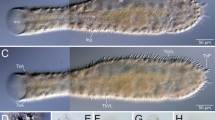Abstract
THE following account shows how to obtain much-improved sections of large heavily sclerotized whole insects. The method should be applicable to many other kinds of animals which present similar problems. Use is made of a fixing, dehydrating, and clearing agent, tetrahydrofuran, which produces a minimum of tissue hardening. It is highly volatile thus permitting rapid removal in the paraffin oven, dissolves paraffin and celloidin. Tetrahydrofuran (furan) has been used by other workers with good results1,2,3. Paraffin infiltration is done in a partial vacuum. The blocks may be soaked 24 hr. or longer in either ‘Mollifex’ (B.D.H.) or in water (preferably with a small amount of detergent) or in 75 per cent alcohol. Before sectioning, the blocks in the soaking medium, if such is used, are cooled to approximately 15°C. Better than average sections are obtained.
Similar content being viewed by others
References
Dahme, E., and Rothemund, I., Zentralbl. allg. Path., 94, 14 (1955).
Haust, M. Daria, Lab. Investig., 7, 58 (1958).
Salthouse, T. N., Can. Ent., 90, 555 (1958).
Palmgren, Axel, Nature, 174, 46 (1954).
Author information
Authors and Affiliations
Rights and permissions
About this article
Cite this article
BECKEL, W. Sectioning Large Heavily Sclerotized Whole Insects. Nature 184, 1584–1585 (1959). https://doi.org/10.1038/1841584a0
Issue Date:
DOI: https://doi.org/10.1038/1841584a0
- Springer Nature Limited





